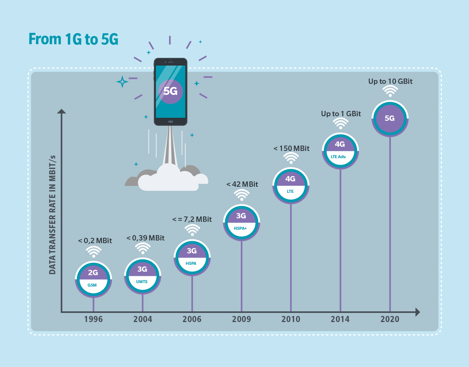Our work and daily life is subject to continuous change fuelled by IT and technology. It is therefore essential to keep an eye on the topics that might be overlooked today but become a key driver for tomorrow. Some trends come with longer lead-times, building on continuous success in their field, others have more of a sudden hype character and burst onto the scene unexpectedly. In 2020, the dominant topic will be AI – no matter if it is the wider adoption and extension of applied fields of artificial intelligence, its implications for process automation or the smart city. Many businesses and applications will be boosted by AI services. Faster 5G connection technology will push this development even further, as it enables the move of digital solutions into mobile networks. However, the user will remain at the crucial centre of all new tech trends. Due to the multiplication of touchpoints, easier access and supported programming, the user will be more in focus than ever. Another decisive topic has been present for the last few years: concerns about digital ethics and data privacy will continue to be highly important and remain on the radar.
1. Artificial intelligence – the dominant topic of 2020
Artificial intelligence (AI) is likely to play a key role in digital transforming and evolving businesses in the next few years1. It will boost applications of all kinds and smarten the way they function even more. We will see a wider adoption of AI as its use is deployed by more and specialised providers such as Konica Minolta. The IT specialist currently provides business solutions that improve software through smart AI support, e.g. Microsoft Power BI, delivering meaningful solutions leading to more efficient working. AI-as-a-service and better affordability will amplify this trend2. As SaaS itself continues to grow, SMEs will benefit from the reduced costs of AI-as-a-service and will be able to drive their businesses more effectively. The increasing number of AI users will be coupled with an increasing number of AI-supported areas: artificial intelligence will be applied in more fields and advance more devices with its technology, widening the scope of possibilities: e.g. improved conversational AI. The security of AI is therefore crucial, while possibilities for increased security through AI emerge as well1. This evolution of AI will also have an influence on other digital processes and their possible automation, which directly ties in with Konica Minolta’s customer-centric approach to business process and IT services.

2. Hyperautomation – automating and evolving a company’s processes
Automation was a key-driver of industrialisation in the past, transforming production processes significantly. Jobs that were done by humans prior to that, are now automated and performed by machines. This trend is likely to experience a renaissance. Thanks to AI support, automation will become relevant once again. Gartner calls this new trend hyperautomation: the increased use of AI in combination with machine learning (ML) and Robotic Process Automation (RPA) will give rise to a variety of processes1. Thanks to Konica Minolta’s experience in this field, the IT specialist is able to automate processes in all departments of a company – from invoice processing to inventory management. The impact is measurable almost immediately, as more tasks can be handled at the same time, errors occur less often or disappear completely, and employees’ workloads are eased. In the future, hyperautomation will be able to create a DTO (digital twin of the organisation) that reflects the entire company and every process digitally1. The benefit created cannot be overestimated: having a digital replica empowers the company to analyse, evaluate and improve its processes accordingly.
3. Analytics – data usage and forecasting for optimal efficiency
Analytics help to evaluate and challenge current processes, improving efficiency by analysing current and predicted data. 2020 will come one step closer to the combination of predictive and descriptive analytics: prescriptive analytics. Many companies still use descriptive analytics, focusing on what happened and base their strategy on that, while others predict future developments to drive their businesses – predictive analytics. Prescriptive analytics combines both approaches and evolves them: it predicts the future and justifies the predictions based on descriptive analytics. Incoming data can easily be integrated, too, and adjust the predictions accordingly3. Improved analytics and the real-time processing of data will lead to analytics as a competitive advantage, as Forbes4 forecasts. Business decisions can therefore be based on reliable sources and analysis, offering an optimal basis for the future. Konica Minolta is becoming a 360-degree partner for a variety of data-driven services and can therefore enable a wide portfolio of analysis in a variety of business divisions. Whether in disciplines such as business intelligence and data warehousing, managing customer relationships through CRM or perhaps leveraging the new opportunities with IoT, data will create substantial value for innovative companies that will lead the way. Together with the major players in IT and technology, Konica Minolta can provide solutions to use data to the best effect, e.g. the Microsoft Power Platform, enabling companies to derive the right conclusions from their data.

4. 5G – accelerating more than just telecommunications
The new standard is gaining more importance after the foundation was laid in 2019. Many big players in the telecommunications industry are likely to focus on 5G. However, the possibilities will go beyond telecommunications. “Super-fast” internet will boost and facilitate the smart city, smart manufacturing, IoT, cloud computing, autonomous driving, mobile devices in the coming year. For this reason, car manufacturers are conducting research into autonomous driving, since 5G is capable of providing the necessary connectivity4. Empowered by increased possibilities through 5G and technological innovation, our daily life in the city will change noticeably, while mobile working will improve, too. The entire manufacturing sector will also benefit from this trend.
5. User-focused technology – the user as the developer and optimally addressed customer
As technology evolves and becomes more complex, it is increasingly important that the user remains at its centre. This is core to Konica Minolta’s approach to the connected workplace and next year’s developments fully support this approach. New technologies will increase access and touchpoints to the consumer – making them more than just users. The so-called democratisation of technology will greatly influence the way IT and software are developed and accessed. A completely new target-group can be integrated into the early stage of development processes by directly building on the input of non-professionals. Today, you do not necessarily have to be a programmer to develop and shape software. With the help of AI, digital code can be generated to allow “citizen access” to emerge – everyone can theoretically take part in IT development. The resultant multi-experience places and IT environments will thus revolve around the user as their centre of focus. A multitude of devices will enable customers to experience increasing touchpoints to technology1. As applications and software become ever more capable, it is essential to ensure that they are very intuitive and simple to use in order to exploit their potential for making operational processes more efficient. Konica Minolta is well aware of this need and therefore offers a holistic approach towards the IT of tomorrow, today.
6. Digital ethics and compliance – taking concerns about technical progress seriously
This trend connects to recent years but will be strengthened in 2020. While we experience some of the biggest transformations in IT and technology ever seen, concerns about ethics and data security increase accordingly. Although GDPR came into force in May 2018, some companies are still struggling to make their processes compliant5. It is important to have a company’s IT compliant with all regulations and requirements – the right business solutions can have a serious impact here. As AI will tie into many people’s jobs, there is still scepticism about self-learning technology, and it is essential to address it correctly. It is becoming increasingly necessary to ensure transparent and trackable handling of collected data. Companies need to ensure that data is used securely and stored appropriately, as more and more users demand information about the type of data that are collected, how they are used and where they are stored1. Digital transformation goes hand in hand with providing the necessary levels of security for the protection of personal data. For Konica Minolta, this digital responsibility goes beyond the legally applicable frameworks because the company understands its data responsibility not only as an obligation to comply with legal requirements and standards to protect data and ensure information security – but also to voluntarily handle individual personal data carefully and responsibly. The company does this because of its ethical understanding of data protection as well as because it is a human right to protect a person’s own data. Konica Minolta thus wishes to ensure privacy and to maintain a person’s sovereignty over their own data and footprint in the digitalised world.
7. Blockchain – the basis for IT improvements in the 2020s
2019 saw a great deal of hype about Bitcoin and cryptocurrencies. Blockchain technology is the basis for cryptocurrencies generally and is expected to dominate the market next year, while the scope of its use will split. One main field will be smart contracts. A blockchain provides a secure basis when signing contracts, as the underlying technology provides a permanent base that cannot be changed. It is also unaffected by the volume or regional concentration of contracts. Escrow agreements in particular benefit from blockchain technology – securing and automating their handling. Another field will be safeguarding assets digitally. On the one hand, a blockchain allows important and crucial data to be integrated and stored. On the other hand, only a specific group of employees can access them, which is especially appropriate in the banking or the medical sector. Additionally, many people are able to access the same database, while access rights are tiered. The supply chain for food products can also benefit from this system6. The “classic” application of blockchain technology in providing the basis for cryptocurrencies may be revitalised, too. Facebook aims to launch its own cryptocurrency in 2020, making it more likely for new hype around cryptocurrencies to continue next year.
1 Gartner Top 10 Strategic Technology Trends for 2020; Gartner; 2019
2 The 7 Biggest Technology Trends In 2020 Everyone Must Get Ready For Now; Forbes; 2019
3 7 Tech Trends to Watch Out for In 2020; Entrepreneur; 2019
4 Top 10 Digital Transformation Trends For 2020; Forbes; 2019
5 How data goverance can support data privacy compliance; CIO; 2019
6 Tech trends that can impact business in 2020; Savvycom; 2019



